FUSION POWER, WHO NEEDS IT ? !
FUSION POWER, WHO NEEDS IT ? !
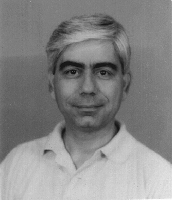
P. K. Kaw
Institute for Plasma Research
Bhat, Gandhinagar 382 424
FUSION POWER, WHO NEEDS IT ? !
Artsimovich Memorial Lecture presented at the 14th IAEA Conference on Plasma Physics and Controlled Fusion, Wurzburg, Germany, 1992
Mr. Chairman, distinguished guests, ladies and gentlemen. It is a great
honour and a privilege to have been invited to deliver the Artsimovich
Memorial Lecture this year. As you are all aware, these lectures not only
honour the memory of Academician Lev A. Artsimovich, a giant among
fusion scientists, but also give one an opportunity of sharing one's
perspectives and concerns about fusion research activity as a whole. To the
extent that they provoke discussion and debate, these lectures serve a very
useful purpose.
Ladies and gentlemen, the title of my talk is "Fusion Power: Who needs
it?!" My chief concern in this talk is that we in the fusion community, have
come to accept a pace of fusion funding which could be better described, by a
title "Fusion Power ? But who needs it, right away?" At a time when our
technical accomplishments worldwide are excellent, and our experiments
are producing beautiful results, we are less than ambitious in our request
for funding. When we should be running, we are barely crawling! Thus no
new tokamaks have been constructed or are under construction for so many
years now, in spite of several excellent proposals. Our next generation
experiments (INTOR, NET, SSTR, ITER) continue to be caught up in the
loop of design and redesign and re-redesign and...We have no major
fusion technology facilities. We glibly talk of 50 years time scales for
commercial systems and so on. I believe that the reason for this state of
affairs is that we, as a community, have formulated a set of questionable
premises (never explicitly stated but more or less tacitly accepted by
everybody). These are:
1. Energy situation in the world is comfortable and there is no urgency to develop fusion technology.
2. Even if fusion technology is developed faster, nobody will buy it, because it will be too expensive.
3. We can develop and perfect the technology over the next 50 years or more and then it may be put to commercial use.
I believe that each one of these premises is faulty and would like to share
my thoughts with you.
I. Are we really comfortable on the energy front ?
I present you a perspective that I know best viz. that of developing nations
like India and China (Similar trends are visible in other parts of Asia,
Latin America and Africa). Table I presents the data on per capita
consumption of electricity in several countries.
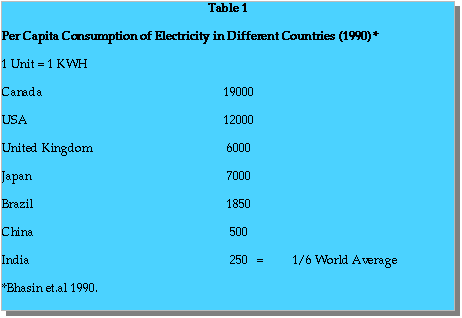
It may be noted that whereas the average consumption in most of the developed world is more
than 6000 units/year, the figure for India is a meagre 250 units/year i.e. 4 percent
of the average in the developed world. Many will argue that the actual
consumption in the developed world today is too high and is likely to come
down because of efforts in energy conservation and improved efficiency of
energy systems. Even if the numbers come down, it is instructive to note
that India today is at 1/6th of world average (1500 units/year). When the
energy planners in India and China think of the immediate future (up to
2020), they at least think of coming up to the world average. What are the
energy requirements then? Table II summarizes the data.
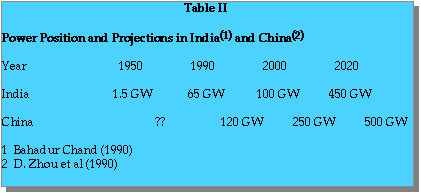
It may be noted
that even at this modest requirement, India and China need ~ 1 terrawatt of
power by 2020. Let us next ask how is this electrical energy likely to be
generated. In the absence of any new technologies, our planners base the
projections on the existing methods of energy generation. Table III
illustrates the distribution of power generation methods in India and China
for the year 1990 and projections for 2020.
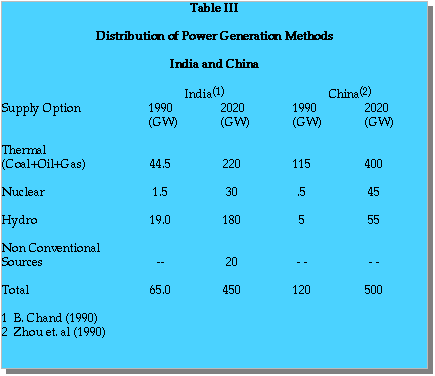
It will be noted that about
1/2 Terrawatt of additional power production will be by burning fossil fuels.
What conclusions can we draw from the above tables ? It is clear that in the
next 20-25 years massive increase in the use of fossil fuels for power
generation is going to take place in the developing world (the typical factor
will be about 5). This will seriously degrade the local environment in these
countries. We already see warning signs in China, which has to uses a lot
of coal for power generation. It has been noted that China already has the
highest atmospheric sulphur dioxide in a country anywhere in the world; acid
rain has been observed in Chongquing, Nanchang, Changsha etc. (Zhou,
et al. 1990). Let us assume that the developing world can live with a
somewhat degraded environment. However, what is likely to happen after
the year 2020 is really frightening. As described above at 1500 units/year
per capita consumption (which is only 1/4th of that of the average in the
developed world), India and China alone will be generating about
1 terrawatt of electricity, half of it from fossil fuels. This is 10 percent of the total
world production today. Beyond 2020, if they bring up the consumption to
that of the developed world and if we add the requirements for rest of the
countries in the developing world, the impact on the global environment is
simply staggering. This means that if we continue to rely on fossil fuels for
our energy needs, we will literally choke up on this planet. Very severe
comparable warnings have come from scientists who have examined the
impact of continued use of fossil fuels on accumulation of CO2 in the
atmosphere and the associated greenhouse effect.
There are other points of concern also for the developing world. The
massive dependence on fossil fuels makes them vulnerable to oil price
shocks. This became very clear during the seventies when the oil crisis
took place. Oil prices have and can be put at a level which is out of reach for
developing countries. It is also important to note that one cannot assume
major contributions to power production from fission power as there are
important questions related to safety, public acceptability and international
safeguards.
So, where does this state of affairs lead one to? It seems that the world will
have to make one of three choices:
A. Every nation in the world must reduce its energy consumption significantly.
B. We allow stagnation of per capita energy consumption in developing world.
C. We have increasing impact of new technologies like fusion, renewable energy sources etc.
Choice A would be made in an ideal world. It is unrealistic to expect that it
will be made in the real one! Choice B seems to be the most likely one. In
fact it is interesting that energy planners in the developed world are already
talking about such scenarios in their futuristic documents (Flavin 1988). What the developing world would really like is that a Choice C be available.
My conclusion is that the energy scene in the developing world is far from
comfortable. The worst scenario is one where these countries are forbidden
to burn coal because of environmental constraints, cannot buy oil/gas
because it is too expensive and cannot use nuclear power because of safety
issues and international safeguards. So, what do they do then? It is
obvious that there is urgency to develop a new technology like fusion.
II. With What Certainty Can We Say that Fusion Energy Will be More Expensive Than Other Energies?
Table IV is extracted from a recent report published in Nuclear fusion and
compares the projected costs of electrical power generation between
thermal, fission and fusion power systems. 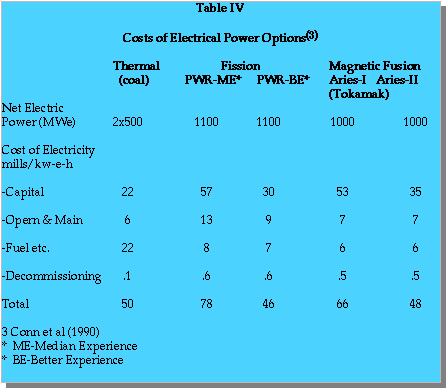
It is to be noted that fusion
power costs are only marginally higher than that of fission and thermal
power. In fact if one makes aggressive assumptions in physics and
technology (as in the Aries II design), fusion power costs are quite
comparable to those of other systems.
Importantly, Table IV also shows that in the thermal power costs, a
significant element is the cost associated with fuel. We must therefore ask,
what determines the cost of fossil fuel? For example, it is clear that there is
nothing like the "real" cost of oil and that the cost is totally determined by
the oil cartels and political conditions in the world. Fig. 1 is an illustration
of how the cost of oil has varied in the past 20 years or so.
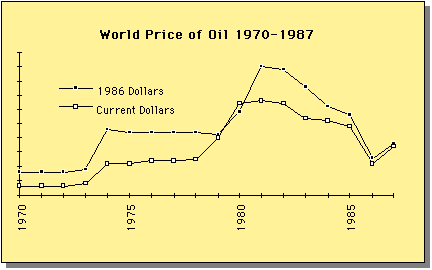
One can see that
in the late seventies, the cost of oil jumped almost by a factor of 3 within
one year. This is because the oil cartels had decided to increase the price of
oil. Another important factor in the cost of fuel is the tax structure in each
country. As an example in Table V we have shown the prices of several
gasoline products in different countries in 1986.
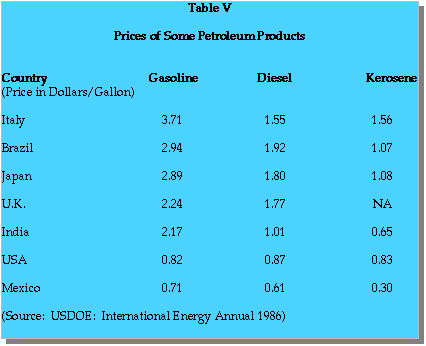
It may be noted that at the
same given time, the prices of gasoline and kerosene varied by as much as
a factor of five between Mexico and Italy. This again clearly shows that
there is nothing like a real price for a given fuel. There are other important
factors involved. At the present moment, a strong environmental lobby is
asking the question, who should bear the cost of clean up of the mess
created by fossil fuels? There are serious suggestions of a Carbon Tax to be
imposed on all fossil fuels, which could readily increase the electricity costs
by 10-20%. I understand from a colleague in Europe that in certain
quarters, a taxation level as high as 50% has been proposed. Other relevant
questions which are being asked are who should bear the cost of security of
oil rich regions, cost of strategic petroleum reserves etc.? Should all these
costs continue to come from general taxation of the public or should they be
internalized in the cost of fossil fuel? We may conclude that it is by no
means certain that the cost of energy from fossil fuels is likely to stay at the
levels where it is today. It could significantly increase. Much will depend
upon how long the various vested interests (oil lobbies, utilities etc.) are able
to protect themselves, through political connections.
The fission power cost column of Table IV illustrates another interesting
point. There is a factor 2 difference in the capital cost between the median
experience (ME) and the best experience (BE) (in fact the capital costs of
fission reactors have ranged over a factor 5 from $1300 to $6000 per kilowatt
electric; Jones et. al. 1990). The basic reason for these substantial
variations is that if effort is put into standardization of equipment, licensing
reforms, improved project management etc., the actual costs can be
considerably reduced (Jones et. al. 1990). Yet another aspect can play a role
in reducing the cost of a new technology when it comes into the market and
starts competing with the existing ones. This is illustrated in Fig. 2, taken
from the data for a renewable energy technology based on photovoltaic cells.
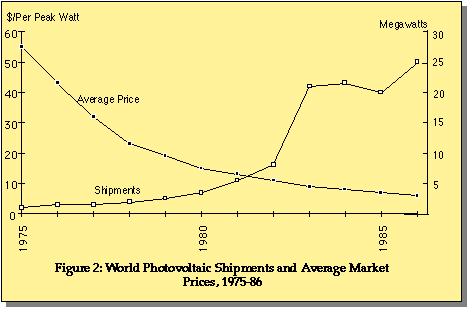
It may be noted that in the early eighties, as the number of worldwide
photovoltaic shipments significantly increased, there was a steep decline in
the average price per peak watt.
So, what may one conclude from the above arguments? Given the
substantial uncertainties described above, can one really say that fusion
power is going to be definitely more expensive than thermal or fission
power? The question that I would like to ask my fusion colleagues here is
that if fossil energy prices go up by a significant factor in a few years, are
we ready with an alternative technology? Can we take over what cannot be
done by fossil fuels at that time? When the fusion community says that we
will not develop fusion today but will, do it slowly over a period of 50 years
because the power it produces may be more expensive (based on uncertain
arguments of the type critically examined above), the lay public thinks
"Here is another swindle for fifty years!" I believe that the time has come
that we actually demonstrate to the taxpayers who support us, in as short a
time as possible, that fusion can indeed produce electricity. Even if our
power costs are higher than those of existing power systems, we would be
far more credible as a group. To give this technology a chance, we must get
it out into the market. Similar things have happened in renewable energy
source systems. Many of these technologies are costlier than present
energy systems but they are out in the market and people can see that they
really work and generate electricity.
III. Can we perfect this technology slowly over a period of 50 years and then put it to commercial use?
I believe that the answer to this question is a definite NO. In 1955, at the
first Geneva Conference, Homi Bhabha had declared that fusion systems
producing energy would be developed within two decades. When in the
nineties, after working on the problem for 35 years, the community goes
around saying that we still need 50 years to exploit fusion as a commercial
technology, it has two negative effects:
(a) One gives a very poor impression
about the actual accomplishments of the programme. Nobody outside the
community really gets to know what it is that has been achieved in the last
35 years. The fact that we are really manipulating large, reactor grade
plasmas that have nearly reached breakeven conditions gets lost;
(b) It leads to a rapid loss of our credibility. When we say that fusion systems still
need 50 years for development, the lay public thinks that perhaps such
systems will work in the twenty second century. The planners do not take
us seriously at all; they probably believe that these systems will never work.
In the past few weeks, I have been scanning the energy planning
documents of several developed and developing nations to see if fusion
energy is included in any documents as a major source of energy
production at any time in the twenty first century. I did not find even a
single mention anywhere. This shows the degree of credibility we carry in
the minds of planners. We simply have not reached them or they do not
believe us. Some of my colleagues will argue that we have to be cautious
and that in the past we have suffered because we promised too much too
quickly. But when caution begins to hurt programmes, it is time to
question the basic premises. We are already on the back burner and let me
assure you that there is a very short distance between the back burner and
the garbage can. If we keep talking of 50 years time scales of development,
it is not clear where we will end up.
There are several other reasons why we should not talk of very long time
scales of development. The fusion programme has made very significant
progress in the past decade. This has given our technical programmes
considerable momentum which is likely to die if we talk of very long time
scales. Secondly, it is important to emphasize that the world has created a
major human resource in the fusion scientists and engineers, some of
whom we see here today. This is an asset which we should not squander
away. There is every likelihood that this group will disband if we talk of
very long time scales. It is also certain that no fresh blood in the form of
bright young people is going to enter a programme which is seen as very
long term. If we ask a bright young man today whether he would like to
join an effort which may lead to something useful fifty to hundred years
down the road, there is every likelihood that he will shun away.
Finally, we must realize that the perfection of a technology only occurs by
competition in the market place. There is no way that fusion systems can
be perfected in the quiet of the laboratories. We thus need to build real life
systems as soon as possible and then let them improve by competition.
IV. A New Goal
I hope that the above discussion has convinced you that we, in the fusion
community, have made a set of faulty premises and allowed them to
dominate our thinking on the pace of fusion funding and fusion research in
the world. I think that it is time to reorient ourselves and define a new goal
which I would like to put down as follows: We must bring fusion systems to
a level such that fusion power is considered as a credible energy alternative
on the fastest, technically realistic, time scale. We must demonstrate
generation of fusion electricity as early as possible and show that it is
environmentally better than the other competing energy sources.
What are our major uncertainties in realizing this goal?
The technological
issues involved are well known to everyone here and we shall hear a lot
more about them during the course of the Conference. Briefly, we must
demonstrate ignition without significant degradation of critical plasma
parameters, impurity control, fueling and ash removal, long pulse or
steady state operation; we must find acceptable new materials for plasma
facing components and first wall, develop hot blankets for breeding tritium,
demonstrate reliability, high duty cycle and safety and so on. Many experts
believe that the above problems can be addressed and solved in 2-4 tokamak
systems, built partly in parallel, over the coming 15 to 25 years. That is, in
principle, we could have a demonstration power plant as early as the year
2015. We must make this a goal of the world fusion programme.
Let us ask what this really requires. The most important thing is that we
have to raise resources for such a programme. At a very rough estimate,
this overall development should cost around U.S. $50 billion in
twenty years. This is by no means a large sum to develop a technology
which will satisfy the energy hunger of this planet for all time to come and
considerably improve the quality of life. Let us put this number in some
perspective. We are nearly five billion people on this planet today. Thus one
is asking for U.S. $10 per person in the next twenty years (50 cents a year!).
Is this too much of a capital to invest for a future energy source? Let us give
another perspective. If one charges 1 cent per gallon "fusion tax" on
gasoline one can generate this much revenue in less than 5 years and the
consumers won't even notice. Yet another perspective. This total cost of
development is likely to be less than the cost of a Space Station which is very
much under consideration in several places. Another perspective can be
given in the form of cost of high-tech defense systems such as SDI which
may indeed be redundant in the present post-cold war era. The total cost of
fusion development is likely to be less than the cost of a few such pieces of
equipment. Thus the total cost of fusion development is not so large that the
world cannot comfortably bear it. It is simply a question of convincing the
right people. But if we have to convince others, we must first convince
ourselves and then speak with conviction. We must spend time in
educating the general public about what fusion can do, what the stakes are
if it is not developed early enough, what our actual accomplishments in the
last 30 to 35 years are and so on. We can learn from the example of NASA
which has done an excellent job of keeping the public informed through
excellent educational material in the form of publications, video films,
advertisements, films etc. We must also develop a strong lobby which will
work for us with various governments and international bodies. We must
establish linkages with other like minded groups who are interested in
improving the environment and quality of life all over the world.
V. Conclusions:
My conclusions are:
1. There is urgency to develop new technologies like fusion since
otherwise per capita energy production (and the quality of life) in the
developing world is likely to stagnate in 20-25 years.
2. The fusion DEMO generating electricity in an environmentally
acceptable manner, should be built as rapidly as technically feasible,
say by the year 2015. This calls for an aggressive development of a
number of parallel systems which solve the various problems of
physics, technology, safety, environmental acceptability etc. Some
pruned version of ITER could be one of the required parallel systems
needed for overall development.
3. To raise resources for an accelerated programme, we must spend
effort in educating the general public, the energy planners, the
environmental groups, the politicians, etc. about the merits of fusion
and about how close we have come to final goal. Resources should
become available because the developing nations can be convinced
that this is the surest means of ensuring a decent standard of living
for their citizens and the developed nations can be convinced that
there is a huge energy market out there which can be tapped and that
they cannot continue to pollute the environment at the rate at which
it is being done at the moment.
4. A few words about international cooperation. This morning in the
panel discussion you heard about developments in ITER and the
international cooperation among the four major blocks. But this
collaboration, totally leaves out programmes in the rest of the world.
I would like to briefly talk about them. Programmes in many
countries, especially some of the developing ones, have now started to
mature and must establish linkages with each other and with
mainstream activities like ITER etc. Considering the importance of
fusion for developing nations, it should be possible to raise resources
for a joint mature experiment which can then address an important
set of questions for the mainstream fusion programme. This can
also be treated as an insurance so that at some point of time in the
future, if the developed nations feel that they would prefer to wait, the
developing nations can take off on their own and solve their energy
problems themselves.
Finally, before I end my talk I cannot resist the temptation of quoting
Academecian L. A. Artsimovich. In response to a query he is
reported to have said "The first fusion system will be built when there
is a great need for it." I believe that if Lev Artsimovich were alive
today, he would have been a rather unhappy man. Not because we
have not taken his technical work seriously. We have indeed adopted
his baby and taken it to new and brilliant heights. He would be
unhappy because we do not share his vision. He would see a world in
which there is great need for fusion, a world where there is technical
ability to develop it but he would ask, "Where is the will?!"
References
1. Bhasin, J.K., and R.N. Srivastava, Proc. National Seminar on Electrical Energy and Environment, Indian National Academy of Enerigneering, Institution of Engineers, New Dehli 110 002 (1989) p. II-1.
2. Chand, B., ibid, P. I-1
3. Con, R. et. al Nuclear Fusion 30. 1924 (1990)
4. Flavin, C. and A. Durning, State of the World 1988 (A Worldwatch Institute Report) Ed. L. Stanke Prentice Hall of India 1989, p. 41; Plavin C. ibid, p. 22
5. Jones, P.M.S. and G. Write, IAEA Bulletin 3, 18 (1990)
6. Zhou, D., G. Write and C. Hu, IAEA Bulletin 3, 24 (1990)
Return to the Office of Fusion Energy Homepage